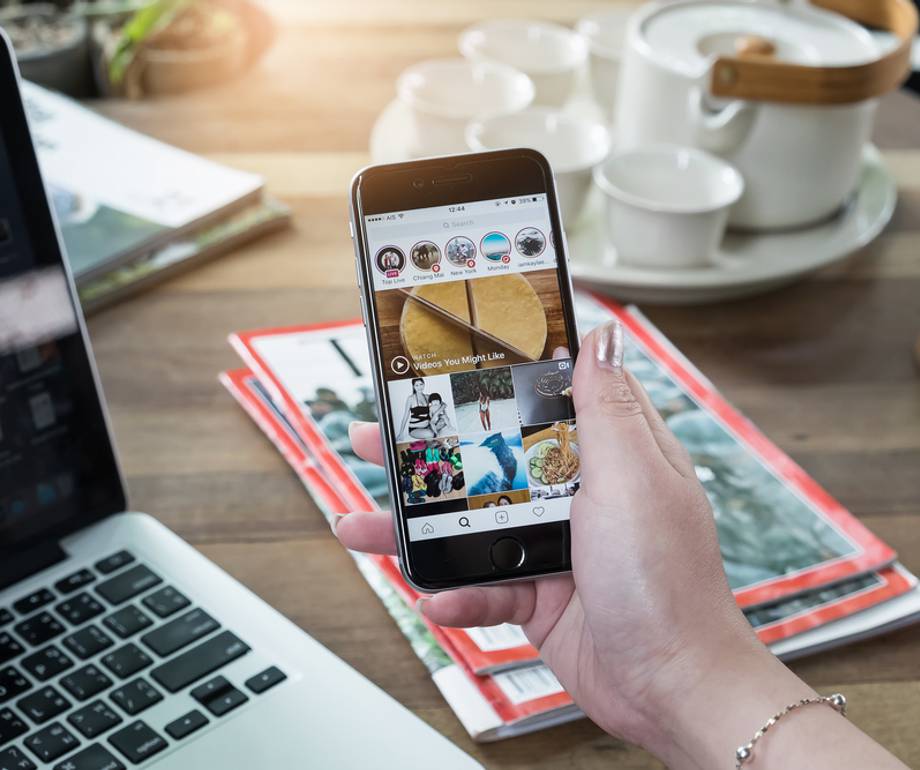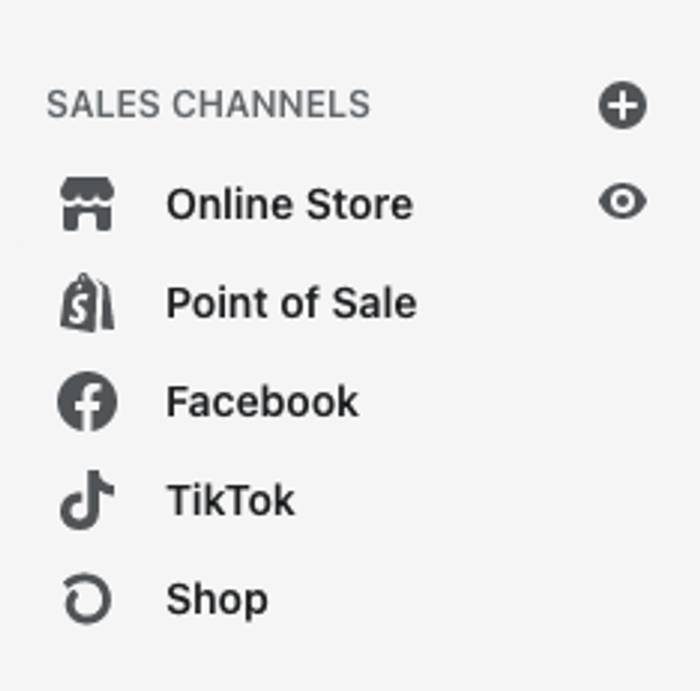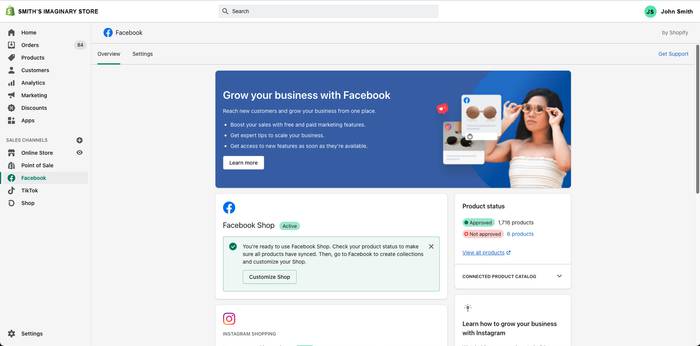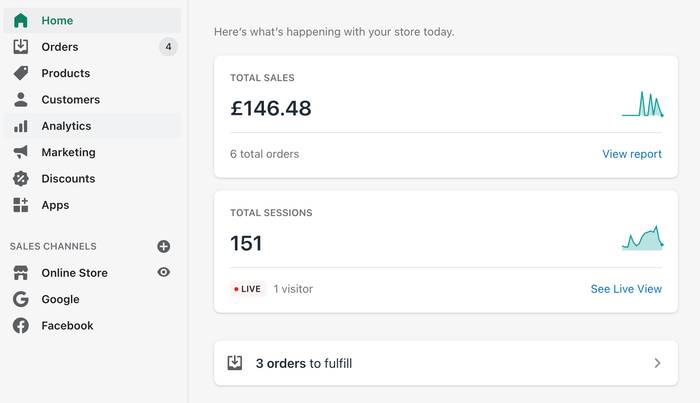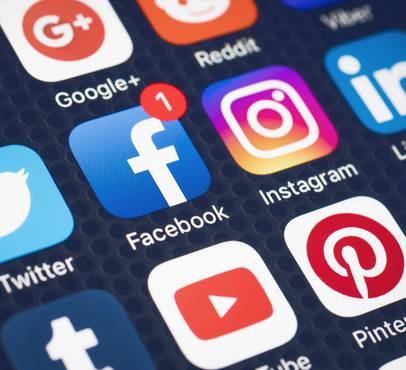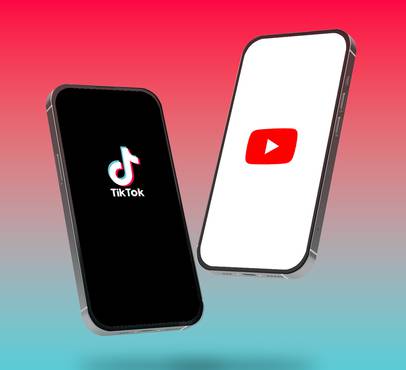Your Shopify site is like a virtual shop window - you can make it look great with quality imagery and a nice design - but simply having it alone won’t necessarily guarantee sales.
You still need to get people through your ‘shop door’, which in the highly competitive ecommerce landscape, can be challenging. This is where social media marketing can help. In a recent survey by Sprout Social, 58% of consumers said they find it more engaging to connect with a brand on social media than to visit a physical store. This presents a fantastic opportunity for Shopify store owners to engage with their target consumers on social media and direct them to their Shopify store.
“Experts predict social commerce to grow 3 x faster than traditional ecommerce over the next four years.”
Over recent years, sales via social media have become a key income stream for many businesses, with the evolution of shopping functionality across platforms like Facebook, Instagram and most recently, TikTok.
With 3.78 billion people actively using social media in 2021, our team of experts have created this comprehensive guide to promoting your Shopify store with social media to drive customers to your Shopify website - boosting brand awareness, consumer trust and ultimately, sales.
1. Online shopping behaviours have changed post lockdown
The pandemic accelerated the growth in online shopping, and coming out of the other side means it’s just going to keep on growing. According to Facebook, “Across the world, 81% of consumers say they've changed a shopping habit since the start of the pandemic, and 92% say they'll continue this new behaviour in the long term.” Those who don’t adapt to the latest online shopping market, will struggle to compete with those who move with the evolution.
2. Instagram’s ramping up their focus on social commerce
Research has revealed that “81% of consumers are discovering new products on Instagram and 80% are using it to make purchase decisions”, so it comes as no surprise that Adam Mosseri, Head Of Instagram, announced in June that shopping was one of the key four areas they were focusing on for the second half of 2021.
3. Facebook is rivaling Amazon & Ebay
In 2020, Facebook rolled out the new Facebook Shops feature that allowed brands to create digital storefronts, but they haven’t stopped there. In 2021, they joined forces with Shopify to integrate the ‘Shop Pay’ button into these virtual shops, making that checkout experience even quicker and easier for customers.
4. TikTok is changing how we shop with #TikTokMadeMeBuyIt
The sharp rise in TikTok over the last 18 months has led to a whole new platform for users to match with new brands and discover products they never knew they needed. Hence, why #TikTokMadeMeBuyIt has 4B views on the app, and the main driving force behind it comes from Generation Z. From makeup and clothing, to gadgets and crafting, there’s an audience for everything on TikTok.
5. Pinterest users are always shopping
Pinterest has worked hard over the years to replicate the in-store moments that shoppers enjoy so much and translate them online, and it’s paid off. As “when brands use shopping ads on Pinterest, they drive 3x the conversion and sales lift, and twice the positive incremental return on ad spend.”
6. Shopify signups (& shoppers) soar
Used by well-known brands such as Red Bull, GymShark and Heinz, Shopify is fast becoming the number one choice for DTC websites, with a staggering 86% increase in revenue in 2020 compared to the previous year. Though the pandemic accelerated this shift to digital in response to the lack of retail traffic and supply chain issues, the DTC market was expected to experience strong growth projections over recent years as more and more businesses strive to streamline their ability to access customers around the world.
“35% of consumers have purchased products or services directly from a social media platform.”
7. You can watch your sales rise in real time on a Live Stream.
One of the latest sales-driving tactics is live streaming eCommerce, which allows you to activate live sales with real time discount codes, meaning customers who tune in have exclusive access to the best deals. Having proved incredibly popular worldwide, but particularly in China, this market has already exceeded $6 billion in total transactions, and is set to continue growing into the future.
Setting your Shopify site up for success on social media
So now you know why social media and Shopify should be used together, but how do you get started when it comes to setting everything up?
Here’s a breakdown of how to integrate your Shopify website with your social channels, allowing you to track, sell and make the most of social commerce features across TikTok, Facebook, Instagram, Pinterest and Snapchat.
How to connect your Shopify to your social media accounts
Connecting your Shopify store with social media couldn’t be easier, you can do this directly from Shopify by clicking the plus next to Sales Channels in the left hand column. That’s it! Once you’ve connected all your relevant social platforms to your site, you can start to manage your campaigns and bring your business one step closer to your target audiences.
TikTok
Shopify integration allows you to set up tracking with ease, as the Pixel can be set up in just one click! You can easily monitor your ads and even set up Conversion campaigns from within Shopify, so you can get a really clear picture of your customer’s journey down the sales funnel.
Update: Since this blog was written, we now prefer to use the 'messy hexagon' model when describing a typical customer journey. Whilst the traditional 'AIDA' sales funnel stills holds value in some circumstances, we believe the messy hexagon provides an alternative and more realistic view of the customer's path to purchase.
“Research from Bazaarvoice, released in May 2021, confirms TikTok has seen a 553% growth in shopping on its app since the start of the pandemic.”
Facebook & Instagram
Shopify now uses one app to monitor both Facebook and Instagram, as you would with your Facebook Ad Account. You can connect your catalogue to ensure that it’s up to date with price and stock changes. Don’t worry, it auto updates and flags if any have not been approved by Facebook. This streamlined process makes it easy to manage your Facebook and Instagram shops as you can access Commerce Manager with one click, and can also easily implement tools such as Facebook’s Conversion API using Shopify’s integration.
One to watch: Businessinsider.com reported that “Facebook is integrating Shopify's Shop Pay buy button into Instagram and Facebook Shops”, but at the time of writing this is still being rolled out in the UK. Find out more about Facebook pay.
Pinterest’s app is beneficial for both Paid and Organic Pinterest. Users of this channel have a higher purchase intent, as they often visit with a specific interest, so it’s got huge potential for driving sales and should be considered by Shopify users who want to get their products in front of potential customers ready to purchase.
You can also promote these pins without leaving Shopify to help boost your products’ reach, helping you reach even more people who are actively searching for products like yours. Find out more on how to utilise Pinterest advertising to promote your site on the Shopify app, to ensure you’re setting yourself up for the best possible chances of success on the platform.
Snapchat
Similarly to other channels, Snapchat’s app allows you to set up and manage campaigns from Shopify’s interface, making it easy to keep track of all your promotional activity. Like Tiktok, this is useful for managing campaigns from a desktop computer, rather than a mobile phone. You can learn more about maximising your advertising success on Snapchat on the Shopify app, which breaks down how to promote your site on the social media platform easily.
Which social-led website plugins to try
A plugin is simply a piece of software code which enables an app like Shopify to be able to do something it couldn’t on its own. Here are some of our top picks for social-led website plugins that you can install on your Shopify site to maximise the impact of your social activity:
- Shoppable Instagram & Tiktok Feed - this utilises your best social content to inspire new customers to purchase with only one-click from your gallery.
- Pinterest Pin It Button - makes it easy for your customers to pin their favourite items to their Pinterest boards whilst browsing your site.
- Facebook Messenger Chat - works exactly like a live chat feature to connect your customer to your customer service team.
- Instagram stories - pulls your Instagram stories and highlights into your website, to get more eyeballs on them and engage more people. Bonus tip: make sure you have highlights that explain how to use your product, or supplementary content such as recipes or style ideas, to convert peepers into purchasers.
- Social loyalty - rewards your customers for talking about you on social media, following you on Instagram, leaving a review or referring a friend. One of the most powerful marketing tools is word of mouth, which on social media has the power to reach significant numbers of people.
- Social testimonials - displays your latest Facebook, Google or Yelp reviews, to save customers getting distracted and going to look for them before purchasing and potentially dropping off during the checkout process.
- Social proof - discrete notifications which fuel FOMO (fear of missing out) by letting others know that someone recently purchased, reviewed or looked at the product they’re looking at right now.
Disclaimer; we haven’t tested all of these before ourselves yet, but we’d love to try them on an upcoming project if you’re interested in utilising any of them, just let us know!
Putting your insights and new integrations into action
Now you’ve connected your social channels to your Shopify site, it’s time to start connecting your products to your audiences, and driving those all important sales.
While our tips will focus primarily on Paid Social tactics, it’s important they’re carried out alongside organic activity for a balanced approach that ensures you’re still creating and nurturing authentic connections with your following as it grows. Both Organic and Paid social activity are key parts of the customer journey - Organic connects people to your brand and stirs their interest in what you’re offering as a whole, while Paid drives awareness and then sales once they’re ready to invest in a purchase - to be successful, the content, tone and style across both must be aligned.
Our top tips on driving Shopify sales through social media
Three out of four consumers buy through their phones because it saves time, so it’s important for your social content to make that path to purchase journey as easy as possible. Here’s how:
1. Include product tags
Be sure to add tags on every product-related post, story and reel you upload as part of your Organic strategy, not just your Paid - you can do this by using the Facebook and Instagram integration mentioned above. According to Instagram, 130 million people tap to reveal product tags in shopping posts each month, so every post has the potential to land a sale!
2. Utilise the catalogue in your Facebook/Instagram advertising activity.
Try running a carousel of products on Instagram with tags that link to the individual product listings, to give swipers and scrollers a variation of products they may like. This features isn't yet available on Facebook, but may become an option in the future. Instant experiences are another effective way of showing customers product catalogues in a mobile only setting - you can use product sets to showcase specific ranges, sometimes also known as Canvas ads - which creates a shoppable experience without leaving Facebook or Instagram.
3. Include swipe up links
Don’t forget to add a link on your stories, especially if you’re linking to a collection, rather than a single product! (For those of you who don’t have the swipe up feature, there is a new link sticker rumoured to be coming soon!)
4. Keep an eye on your Shopify insights
Data analysis is key when it comes to tailoring your approach. If the figures are telling you that an item is gaining popularity, create an Instagram Reel or hop on Instagram Stories to draw more attention to the product, driving even more attention to it. Whether that’s showing different ways to wear it or use it, shouting about the benefits or evoking those FOMO fears by telling your audience it’s selling fast.
5. Use related keywords
Be sure to include relevant keywords in your organic content and product listings to improve visibility. Pinterest, Instagram and TikTok all use keyword data to decide on when a product or post gets shown, so make sure that you’ve invested some time into optimising your descriptions, headlines and copy so you can appear right in front of your target audience when they’re in that discovery phase.
6. Run paid advertising campaigns that target each stage of the sales funnel
Again, your data and insights provide huge benefits here, as you can use visitor’s website behaviour to funnel them into Awareness, Consideration and Conversion audiences. For example, you can run an awareness campaign to target people who look like your existing website visitors with an educational video on your product, or if you’re using Facebook or Instagram, you can utilise the catalogue to showcase products and influence purchase consideration. You can also try running dynamic retargeting campaigns to target customers who have abandoned their baskets to drive conversions.
Discover more about your Paid social media strategy in our blog post, Who should my social media ads target?, where our Paid Social Lead Laura discusses various tactics to help you maximise the impact of your budgets.
7. Pull in User Generated Content
Repurpose UCG from social media onto your product detail pages, to show how others have styled or used the product - this is great for building trust with new customers and converting into sales, as well as engaging with your existing and loyal followers. Just be sure you have their permission before sharing anything!
8. Ensure every link you put out can lead to sales.
Add your store link with a tracked URL to your bios to make it as easy as possible for your consumers to buy from you. If you’re using Instagram, you can also hook into link sharing tools like Linktree that allow you to add multiple links to your bio.
How to report on your social success in Shopify
Measuring the impact of your social activity is key to your success - across both Paid and Organic activity - applying the learnings of what worked well and what can be improved to future campaigns and budget planning.
Here’s where to look in Shopify to track how your social activity is performing.
Shopify Analytics
From your dashboard, head to;
- Online store sessions by traffic source to see how social is performing for traffic against other marketing channels.
- Online store sessions by social source to see which social channels are driving the most traffic.
- Sales by traffic source to see how social is performing for sales against other marketing channels.
- Sales by social source to see which social channels are driving the most revenue through your Shopify store.
Shopify Marketing
The Marketing tab in Shopify shows results from any social ads and other marketing activity such as abandoned basket emails that were created within Shopify. For further details on how to use the email marketing opportunities from Shopify, please visit the website.
Shopify Products
From the products tab, you can click into individual products within your Shopify store to see where sales are coming from. Simply select a product and then click ‘view details’ on the ‘insights’ tile for a Net sales by channel breakdown. This means that if a product is particularly popular on one channel (e.g. if a post went viral on Instagram) you’ll be able to see the results from within Shopify’s interface.
A word on UTM tags…
Use them, or lose that insight! You can track sales via social media in Shopify (and Google Analytics) through using UTM tags. One of our favourite (free) tools for creating these is Google’s Campaign URL Builder. Like we said earlier, data is key, so any opportunity to gather insights to help better shape your future strategy and online activity - especially when it’s free - should be grabbed with both hands!
Is Social really good for Shopify?
We understand promoting your Shopify site through social media might seem overwhelming at first, but in experienced hands, it really can drive a huge amount of traffic to your Shopify site - and sales. Integrating social and Shopify to connect your brand to new audiences across the various social platforms enables you to expand your reach far and wide, and when aligned with your wider marketing strategy such as PPC marketing tactics, you’ll be setting yourself up for success!
Whether you’re looking for someone to handle all paid and organic activity, or simply some consultancy while you handle the main bulk of it in-house, our team of social media experts are here to offer their wealth of insight.
Fancy a chat about your social media strategy?
Get in touch!Post by

Since forming Extreme’s social media department back in 2012, our Head of Social Donna and her team’s work has been recognised nationally. With extensive experience spanning mutiple sectors, Donna specialises in social strategy, ideation and paid social advertising.
Project
Post by

Laura joined Team Extreme in 2017 and through the years has refined her social media skills to become our Paid Social Strategist. She works with our social clients to plan and execute content across a broad range of sectors and channels, helping clients maximise their results and ROI.
Project
